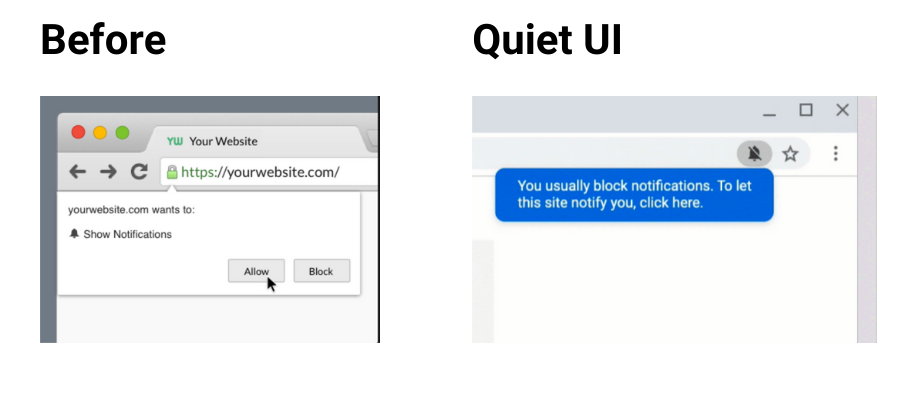
Less than a week left until Chrome 80 is out in the wild, and publishers should be geared up for whatever Google brings to the table.
The announcement on the Chromium blog triggered an avalanche of questions about how this update is going to impact monetization profits from Push ads.
Let’s dive right in and get to all the details.
What are these updates about?
Chrome has recently revealed that it’s planning to change the Push subscription process on some websites.
In essence, in certain cases, the permission request will be automatically blocked. Instead of traditional permission dialog popup, a bell icon will be shown in the address bar.

- This change does NOT affect all the websites
- Even if the permission request is blocked, users still can manually subscribe to receive Push notifications
- These updates will affect both desktop and mobile websites
A similar move was made by other popular browsers – Mozilla Firefox and macOS Safari.
How does Chrome decide when to block?
Chrome says that there are two scenarios when a Push opt-in request can be automatically blocked:
- The website has low opt-in rates – a majority of users have blocked Push Notifications on this website. What’s important is that websites with high subscription rates will not be affected.
- A user constantly blocks Push Notifications on all websites – users who don’t like this communication channel never subscribe anyway, so you’re not losing anything.
Do we have reasons for worrying?
In search of answers, we turned to Karina Arkhangelskaya, the Head of the Propush.me monetization platform. We asked Karina to explain what consequences these changes may have for publishers.

Karina Arkhangeskaya says: “Although it’s hard to forecast the actual effects of Chrome 80 updates, I’m not expecting any major disruptions in the way Push ad format performs.
Also, we probably won’t see any immediate shifts because all internet users will not move to Chrome 80 in one minute, there will still be a share of users in Google’s earlier versions and other browsers. Another aspect supporting the idea that publishers shouldn’t fear the “instant” drop is the speed at which users update Chrome. It will definitely take some time.
Meanwhile, we don’t know what Google means with a “low” opt-in rate. Very likely that Google doesn’t know either. They need to collect sufficient data, analyze the situation, and only after that, I believe, they’d make the serious steps. Push Notifications is the technology that Google has been heavily investing in for a few years now, so the chances of “killing” Push are miserable.
Talking about publishers’ profits. Everyone is very concerned with this part, right? But again, there are no reasons for panic. Even if the number of subscribers drops, the money would go up because the lead quality will also improve. Publishers using Revshare would benefit the most.
Our team closely follows all the developments, even minor ones. And we are ready to adapt and make the most of the change that’s in store.”
How to get more subscriptions?
We summed up the recommendations from Chrome and our monetization specialists on how to increase your Push Notifications profits and improve the UX of your website.
1. Mind the user journey
Find the right moment to show the permission request. Don’t prompt users to subscribe when they first arrive at the website. We recommend to delay this moment and wait until the user acquaints with the content of your website.
2. Explain what will happen after
It’s important that a user understands why he should subscribe, his benefits, and what will happen after he subscribes. Compare these opt-in requests:
No information, but lots of requests


Here are some better examples:



3. Make it clear if the subscription is needed to use a feature of your website
If certain functionality of your website depends on Push subscription – notify users about that. For example, if you monetize with Content Locker – explain how it works, don’t just silently prompt them to opt-in.

We recommend testing Content Locker – it’s a tool that can increase your monetization income! Read more – Interview with Dhruv C.: Monetization, Websites, and Content Lockers
